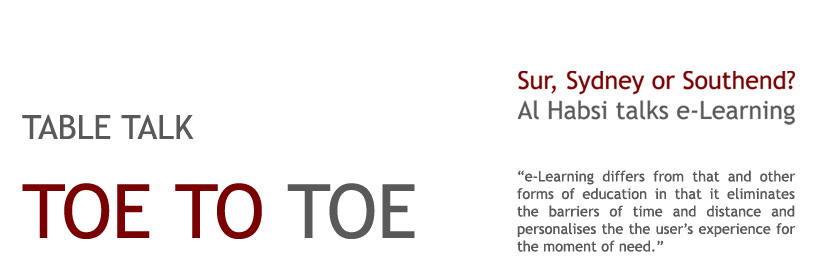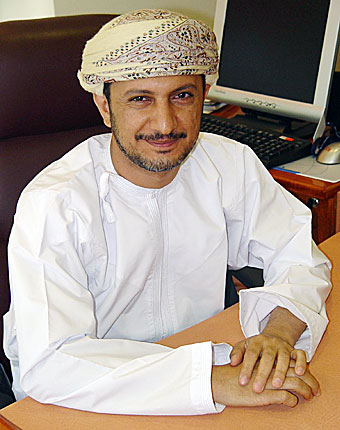

Sultan Al Habsi is Executive President of the Public Establishment for Industrial Estates (www.peie.om) and sits at the heart of Oman’s technology revolution – with offices on Knowledge Oasis Muscat (www.kom.om) – he’s responsible not only for Oman’s six industrial estates but also oversees the management and development of KOM, the 64 hectare, Rusayl-based, technology park. In addition to the 30 plus firms operating on the park, KOM is home to two of Oman’s leading IT tertiary institutes - the Middle East College of Information Technology (MECIT) and the Waljat Colleges of Applied Sciences. Indeed, with over 1,000 undergraduates following a variety of IT degree programmes, KOM’s rapidly developing an international reputation for promoting IT education.
Following on from the success of KOM’s annual e-Games conference (www.egames-online.com) and the spectacular growth of IT education on KOM, DO sat down with PEIE’s EP to talk about e-Learning, this is what he had to say on the matter.
DO: There are a few definitions of E-learning knocking about. How do you lock it down?
SH: You’re right, there are a variety of e-Learning definitions floating around at the moment, I think the American Society for Training and Development’s definition is about the best: “e-Learning covers a wide set of applications and processes, such as Web-based learning, computer-based learning, virtual classrooms and digital collaboration. It includes the delivery of content via Internet, intranet/extranet (LAN/WAN), audio- and videotape, satellite broadcast, interactive TV, and CD-ROM.” However, what this definition doesn’t specify is that e-Learning is interactive, or rather, provides instructional interactivity. E-Learning may have had its origins in computer-based training, which in my opinion was an attempt to automate traditional education without changing the model. But e-Learning differs from that and other forms of education in that it eliminates the barriers of time and distance and personalises the the user’s experience for the moment of need. Computer-based training is nothing more than recorded education, if you will, it’s a solution looking for a problem. E-Learning is the solution to the current problem.
DO: So, what do you see as the main advantages of e-Learning?
SH: I think there are three points worth mentioning here:
1). Individualization. Each learner can work at their own pace. There’s no getting lost because other learners are better prepared or getting bored because others need more help.
2). Active participation. e-Learners can be continuously active, working on tasks that are tailored to their precise needs and levels of readiness. They can face challenges first-hand, practice as much as needed and develop confidence in their abilities to perform authentic tasks.
3). 24/7 – anywhere, anytime. There’s no need to travel – you can be in Sur, Sydney or Southend, geography’s irrelevant. Learners can begin at the most meaningful time for them, work at the most convenient and cost effective locations and study when their schedules allow it.
DO: We understand that PEIE-based manufacturers are keen to invest in e-Learning for their employees – so we’ve a question of ROI - how do you think e-Learning success should be measured?
SH: This is certainly a tough issue - evaluation should be based on how cost-effectively they produce targeted behaviours, and ultimately, how valuable the outcome behaviours are to the individual and the firm. Look, as markets get more complex, the tools we need to keep our people ahead of the game will need to be ever-more sophisticated – and don’t think for one moment that our competitors aren’t thinking like this. It’s our job to encourage PEIE-based manufacturers to recognise e-Learning as a crucial weapon in attaining competitive advantage.
Let’s imagine we’ve got Rashid working on a screwdriver production line in a factory based on PEIE’s estate in Sohar – suddenly his machine jams and the production line comes to a grinding halt. Without missing a beat, the e-Learning system scans the network for a screwdriver machine operator expert. It finds one in Manchester. He is able to receive the specs of the current situation and routes a videoconferencing call with Rashid back in Sohar. The Mancunian expert walks Rashid through the repair process then records the whole session for future reference. Now, this is when e-Learning really kicks in and is of value to Rashid and his firm.
DO: How should we judge when e-Learning is successful?
SH: You need to look at what actually happens to the students, their reaction to it, their perception of it, the way they respond as they’re learning and what they’re capable of doing once they’ve gone through an hour or 20 hours of this learning - that’s the real challenge. Are you delivering on that? Are you doing something different than they would get from reading a book or sitting in a lecture theatre? In my view, e-Learning has to be judged by how well it supports the students and the quality of their learning.
DO: So, where do you think e-Learning will be in 5 years?
SH: I’d rather you ask: ‘How will we be learning in five years’ time?’ I’d say learners will need to develop skills and acquire knowledge that will equip them for life. So by 2010 the majority of learners will see computers as a gateway to learning and an essential tool for information gathering and communicating. People will become life-long learners and attitudes towards studying will alter radically.
With developments on the Web, active learning will be more widespread with learners becoming experts in finding, absorbing and recalling information. Learners will use the Net and mobile devices to find information that’s relevant to them and their interests. Indeed, in this regard, we’ll see a huge growth in just-in-time-learning. Just as the printing press in about 1450 changed the face of learning, the digital age will have a similar impact.
The Basics
e-Learning terms you should be familiar with:
- e-Learning: Interactive learning that uses computer and communication technologies to train or educate. Instead of replacing a teacher/lecturer with a computer, technology is woven into all aspects of the educational process, including its design, delivery, testing and application.
- Distance Learning: Uses material such as textbooks that aren’t necessarily technology driven but simply gets mailed to a remote student. It removes the need to be in the same place at the same time as an instructor.
- Computer-based Training: Self-paced portable content – typically available on CD.
- Web-based Training: Uses the computer as the instructional media to link the learner and instructor.








